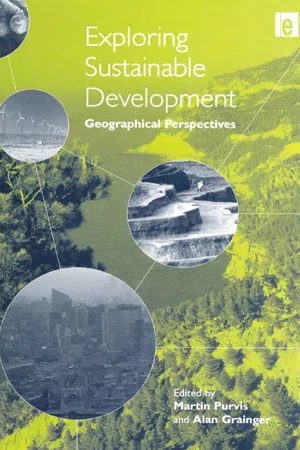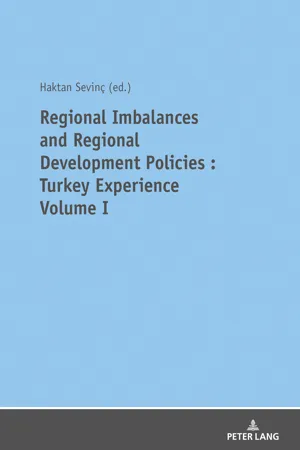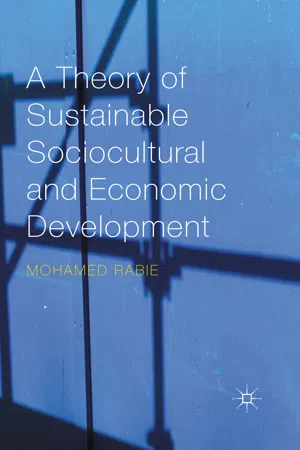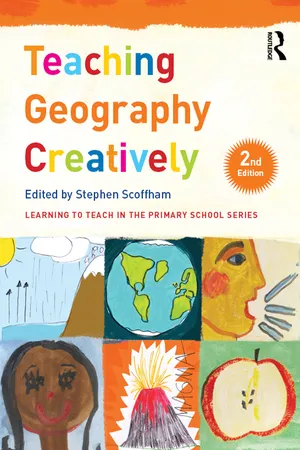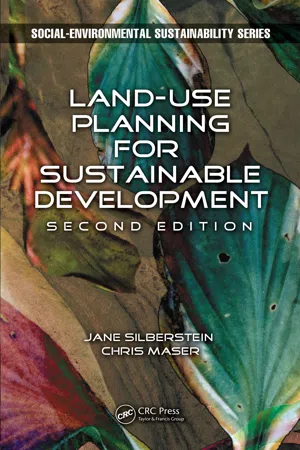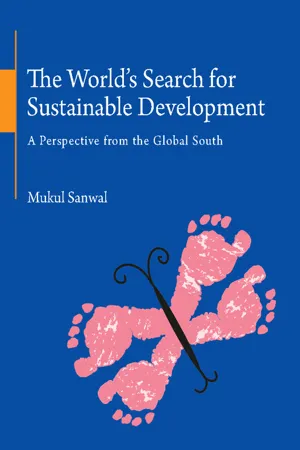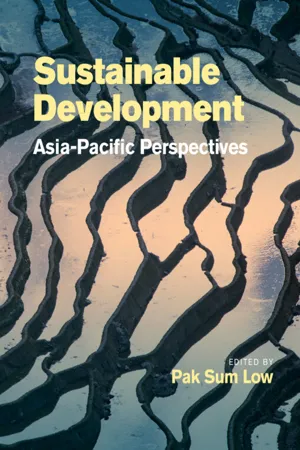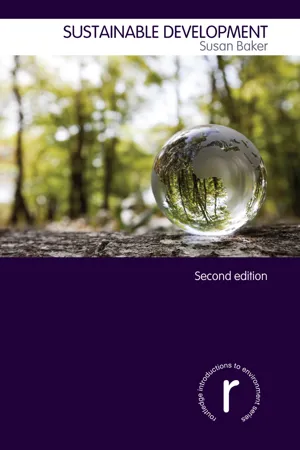Geography
Sustainable Development
Sustainable development refers to the practice of meeting the needs of the present without compromising the ability of future generations to meet their own needs. It involves finding a balance between economic growth, social progress, and environmental protection. Sustainable development aims to create a stable and equitable society that can thrive without depleting natural resources or causing harm to the environment.
Written by Perlego with AI-assistance
Related key terms
1 of 5
11 Key excerpts on "Sustainable Development"
- eBook - ePub
Exploring Sustainable Development
Geographical Perspectives
- Martin Purvis, Alan Grainger(Authors)
- 2013(Publication Date)
- Routledge(Publisher)
2
Geography and SustainableDevelopment
Martin Purvis
Introduction
The current state of the world has led many commentators to conclude that the unequal priority given to economic growth, social welfare and the health of the environment renders established development patterns unsustainable. The alternative ideal of Sustainable Development – that which ‘meets the needs of the present without compromising the ability of future generations to meet their own needs’ (WCED, 1987) – has, therefore attracted increasing support. But once we look beyond such broad definitions, much remains elusive and contested about Sustainable Development. As noted in Chapter 1 , the scope of existing economic theory is limited, and few others have taken up the challenge of establishing a sound theoretical foundation for future action. It is, of course, also true that the label of Sustainable Development is applied to an increasing number of practical measures. However, the sheer number and diversity of such initiatives, and the mixture of motives that inspire them, only adds to the ambiguity which surrounds the concept. There is still, therefore, much work to be done if Sustainable Development is to be established as a credible blueprint for the 21st century.The chapter begins by comparing geography’s long-standing interest in both society and nature, and the links that unite them, with the new agenda of Sustainable Development. This is followed by a brief review of the attention given to Sustainable Development in the geographical literature, and to the themes of place and space in discussions of Sustainable Development. The chapter then moves on to consider the potential for applying geographical skills in planning for more Sustainable Development. Arguably more important, however, is a greater geographical contribution to critical reviews of current thinking about Sustainable Development, both in practice and in theory. - eBook - PDF
REGIONAL IMBALANCES AND REGIONAL DEVELOPMENT POLICIES
TURKEY EXPERIENCE VOLUME 1
- Haktan SEVINÇ(Author)
- 2020(Publication Date)
- Peter Lang Group(Publisher)
Sustainable Development is oriented towards the achievement of well-defined and explicit ecological, social and economic objectives, ii. Sustainable Development aims at human and community development while trying to keep human consumption within the limits of the ecological system, iii. Sustainable Development is a process that is initiated by government inter- vention but cannot be advanced without the inclusion, leadership and coop- eration of the private sector, iv. Sustainable Development is a process which is based on scientific, conscious and democratic practices in all areas of public domain, v. Sustainable Development cannot be achieved if policy integration and coordi- nation are not achieved at all spatial scales and among relevant jurisdictions. Lonergan (1993) also advocates that space should be taken as an integral element in any analysis of Sustainable Development since development is constructed his- torically and spatially. According to Lonergan (1993) Sustainable Development is about attaining a more equitable human society internationally, nationally and intergenerational. Such a challenge requires narrowing the gap between the Regions and Sustainable Development 41 developed and developing nations, ensuring future generations to have at least the same living standards we have been enjoying and ensuring a better distribu- tion of resources both within and among countries. From an economic point of view Daly (1992: 185–186) distinguishes three spe- cific areas of action for achieving sustainability. The first area is “allocation” and it refers to the efficient use of resources for delivering for the needs of the human beings. Allocation includes apportioning scarce resources for the production of goods and services preferred by the people; it is “the relative division of the resource flow among alternative products”. In brief, allocation means equitable distribution of the resources among alternative usage areas. - Mohamed Rabie(Author)
- 2016(Publication Date)
- Palgrave Macmillan(Publisher)
Nevertheless, nations were able to agree on a joint view at the Rio conference of 1992. But 20 ● A Theory of Sustainable Sociocultural and Economic Development since what is feasible today is unlikely to be feasible tomorrow, sustainability should be viewed and treated as a state of transition to a desirable state of living. Societal and global developments are evolving processes that transform all aspects of life and involve all actors whose actions affect life, such as people, technology, culture, and weather; they also involve actors affected by nature and human actions, such as water resources, the environment, and the air we breathe. Emphasizing the interdependence between humans and nature, the Brundtland Commission Report stated, “The environment does not exist as a sphere separate from human actions, ambitions, and needs, and attempts to defend it in isolation from human concerns have given the very word ‘envi- ronment’ a connotation of naivety in some political circles. The word ‘devel- opment’ has also been narrowed by some into a very limited focus, along the lines of ‘what poor nations should do to become richer.’ But the ‘environ- ment’ is where we live; and ‘development’ is what we all do in attempting to improve our lot within that abode. The two are inseparable.” 14 The Legrand Group says, “The concept of Sustainable Development is based on a set of requirements. It must allow the basic needs of present and future generations to be fulfilled with regard to demographic constraints, such as: access to water, education, health, employment, and the fight against hunger.” The report argues further that development should aim to improve the quality of life, which involves easier access to medical care, social services, and culture.- eBook - PDF
- Stephen Scoffham(Author)
- 2016(Publication Date)
- Routledge(Publisher)
While time will tell the effectiveness of the Sustainable Development Goals, the proactive language sets out a clear agenda for the role of education and institutions in actively promoting Sustainable Development. Sustainable Development is commonly thought of as having three mutually support- ing dimensions – economic, social and environmental. These work together and link to the idea of quality of life for all, recognising that we live in an interconnected world. They also relate to some of the ‘big’ questions that geography seeks to answer, namely: n Where is this place? What is it like and why? n Why and how is it changing? What will it be like in the future? What kinds of futures do we want? n What do people do here? How are their actions influenced by, and how do they impact on, environments at different scales? n How is this place connected to other places? How am I connected to other people and places? n Who gets what, where, when and how? Who decides? n What’s it got to do with me? Why should I care? Sustainability education is relevant across the entire curriculum and is best approached through holistic teaching and learning. It has a particular association with geography and requires careful underpinning with geographical thinking and knowledge. Issues concern- ing sustainability and the environment have a values-led and affective base, often articulated as a need to ‘care for the world’, which can sometimes eclipse other necessary components of knowledge and critical thinking. While values and emotions are intrinsic and inescapable facets of sustainability, being properly equipped to respond to these issues also demands some degree of cognitive understanding about how and why human, biological and physical worlds interact with and affect each other. - Jane Silberstein M.A., Chris Maser(Authors)
- 2013(Publication Date)
- CRC Press(Publisher)
1 1 Sustainable Development: The Concept Introduction An awareness of disastrous consequences, brought about by historically proven unwise choices, provides us with the opportunity to change the way we do things so that we can alter an outcome. But, before we can alter the out-come of any historical trend, we must ask fundamentally different questions. One such question is: What is sustainable community development? From our perspective, it is a process of continuous improvement in which the com-munity is constantly evolving and making changes to accomplish its goals. Continuous improvement in this context means a nonlinear process of systems thinking that accounts for the social significance of nonmaterial wealth, qual-itative values, and the heritage of both cultural diversity and identity. It is a process that views humans as an inseparable part of nature and development as directed change leading to social maturation. The resulting psychologi-cal transformation is characterized, in part, by people voluntarily reaching beyond the immediacy of self-centeredness in a conscious effort to be account-able for the effects present decisions may cause in the future. Development thus becomes a process of change guided by the principles of social-environ-mental justice for all living things present and future, not just humans. To understand this better, we have identified eleven essential elements of sustainability: 1. Understanding and accepting that we cannot touch any part of a system without affecting the whole of it—the “water bed principle”; 2. Understanding and accepting nature’s inviolate biophysical prin-ciples, which determine the quality of human survivorship; 3. Understanding and accepting that we do not—and cannot—man-age nature; 4. Understanding and accepting that we tend to make an ecosystem more fragile when we alter it; 5. Understanding and accepting that we must reinvest in living sys-tems even as we reinvest in businesses;- eBook - PDF
The World's Search for Sustainable Development
A Perspective from the Global South
- Mukul Sanwal(Author)
- 2015(Publication Date)
- Cambridge University Press(Publisher)
This transformation is in line with the core objectives of the Charter of the United Nations ‘to save succeeding generations from the scourge of war’, ‘to promote social progress and better standards of life in larger freedom’, ‘to employ international machinery for the promotion of the economic and social advancement of all peoples’, and ‘to be a centre for harmonizing the actions of nations in the attainment of these common ends’. The concept of Sustainable Development represents a shift in understanding of humanity’s place on the planet from the view that emerged in industrialized countries with the shift of population from agriculture to urban areas, of conquering nature for human well-being. Now, there is a broad agreement that society needs to change, though there are major debates as to the nature of the outcome, the changes necessary and the tools and actors for these changes. In most cases, people bring to the debate already existing political and philosophical outlooks, and use similar words to mean a wide divergence of perspectives on the goals and methods of moving towards Sustainable Development. The emerging view, largely in states with large number of rural poor, is that the process of global change is driven by three distinct yet interrelated factors – urbanization, energy/natural resources linkages and scientific and technological advances; interdependence in a globalizing international economy is shaped by patterns of natural resource use; and the direction and nature of human society and civilization is towards greater equality. In this view, the international community in the United Nations is the forum for collective review and management of the process of global change to enable well-being of all. 23.2 Integrated global agenda Sustainable Development goals are now considering people and planet, rather than countries. - Sushila Sinha(Author)
- 2020(Publication Date)
- Society Publishing(Publisher)
The word sustainable is included in the dictionary (of the English language) and this occurred in the year 1987 (Newton and Freyfogle, 2005). As such, in the period from 1713 to 1987, the idea of sustainable was used in a number of publications and discussions, but without having a consistent conceptualization of its meaning. The term sustainable can be conceptualized as a basis, also, as an umbrella term, which provides support and further, includes the idea of sustainability and Sustainable Development (SD), having the worry about the future existence of natural resources in order to support the continuation of human life as its foundation. According to Bell and Morse (2008), Moldan et al. (2012), Sartori et al. (2014), the sustainability can be understood which consists in the capacity of the global system, containing the integration of human environment with an indissoluble system, for maintaining its quality and/or property in a level close, either equal or superior to the historic average, and also, considering the dynamic alterations which are provoked by variables throughout time. Introduction To Sustainability: A Global Perspective 5 As per the highlights which are provided by Horbach (2005), and Dempsey et al. (2011), the sustainability is considered as the union of three types of interests at the same time and in balance, further including the environmental, economic and social aspects. Faber, Jorna and Van Engelen (2005), defend that sustainability comprehends the balance as well as the mutual interactions in between the object and its supporting environment, without having any harmful effects on both.According to Ferreira (2010), the concept of sustainability is a condition or quality of something and this condition can sustain, defend, maintain or conserve something else.- Pak Sum Low(Author)
- 2022(Publication Date)
- Cambridge University Press(Publisher)
different nations placed widely differing demands on the bio- sphere, with the rich pre-empting and wasting many cheap natural resources, whereas the poor were often left with no option except to destroy them; 4. developing countries must rely on their own judgment, rather than following in the footsteps of the industrialized world; 5. the principal means of achieving both environmental and developmental goals is to find alternative patterns of lifestyle and development; and 6. this generation must not jeopardize the well-being of future generations by squandering the planet’s resources. Concerns voiced at Stockholm and the subsequent interna- tional conferences have led to the evolution of the theory and practice now known as Sustainable Development. At its core is the requirement that current practices do not undermine future living standards: present economic systems must maintain or improve the resource and environmental base, so that future generations will be able to live as well as or better than the pres- ent one. Sustainable Development does not require the preserva- tion of the current stock of natural resources or any particular mix of human, physical, or natural assets, nor does it place arti- ficial limits on economic growth, provided that such growth is both economically and environmentally sustainable. The param- eters of Sustainable Development are broad, encompassing fiscal policy, international trade, industrial strategies, technology applications, labour rights, living conditions, natural resource conservation, and pollution reduction – in other words, all the components of development. 10 MOSTAFA KAMAL TOLBA resources and the growing divergence of need, interest, and power among countries at different stages of development. It is necessary, in the interest of all, to seek adjustment of these dif- ferences so that Sustainable Development of the poorer regions of the world receives first priority.- eBook - PDF
Towards Sustainable Development
On the Goals of Development - and the Conditions of Sustainability
- Oluf Langhelle, W. Lafferty(Authors)
- 1999(Publication Date)
- Palgrave Macmillan(Publisher)
Sustainability is, in other words, a conditional restriction on human development (Maines, 1990:5). There have been several attempts to expand on the definitions in the Brundtland Report. As Olav Stokke (1991) points out, the definitions in the report call for further expansion and refinement. What is alarming, however, is that these attempts at making the definition more precise and operational have partly shifted the normative scope stipulated in the Brundtland Report. As used in Our Common Future, Sustainable Development is linked to both the relation- ship between generations and to that within our own generation, on a national and global basis. There has been a strong tendency, however, to apply the con- cept only to the relationship between generations. This apparently marginal change in perspective has a number of normative implications which alter the meaning of the concept. In the extreme case this can mean that the North- South dimension -the relationship between rich and poor- becomes more or less defined out of the concept. In our opinion, this is clearly a turn in the wrong direction with respect to the intentions in the Brundtland Report. In spite of the diversity in people's understanding and use, and of the term being in danger of becoming a new hackneyed phrase, there is much to indicate that Timothy O'Riordan is right when he asserts: 'Like it or not, Sustainable Development is here to stay' (1993:37). Sustainable Development emphasises normative dimensions that no ideology or politics can ignore or fail to address, and one would be hard put to find a set of values that has attained a comparable level of political recognition. In this introduction, we shall sketch some of the major contradictions in understanding the concept of Sustainable Development, and try to present an understanding and usage which is constructive with respect to the numerous programmes employing the idea as an overriding goal. - eBook - PDF
- Susan Baker(Author)
- 2015(Publication Date)
- Routledge(Publisher)
Moving along the continuum, sustaina- ble development becomes a challenge to develop a more environmentally friendly approach to planning and resource management. Moving further along, nature is allowed to set the parameters of economic behaviour, so that Sustainable Development becomes an ‘externally guided’ development model, based on planetary limits. Reaching the other extreme, so deep is the green philosophy that Sustainable Development is viewed as managerial interference with nature and her natural cycles. - eBook - PDF
Sustainable Development
Constraints and Opportunities
- Mostafa Kamal Tolba(Author)
- 2013(Publication Date)
- Butterworth-Heinemann(Publisher)
We in the environment movement must shoulder some of the blame. It has become an article of faith, a shibboleth: often used, but little explained. Does it amount to a strategy? Does it apply only to renewable resources? What does the term actually mean? In broad terms the concept of Sustainable Development encompasses: 1. help for the very poor because they are left with no option other than to destroy their environment; 2. the idea of self-reliant development, within natural resource constraints; 3. the idea of cost-effective development using different economic criteria to the traditional approach (a subject I shall discuss in some detail shortly); that is to say development should not degrade environmental quality, nor should it reduce productivity in the long run; 4. the great issues of health control, appropriate technologies, food self-reliance, clean water and shelter for all; 5. the notion that people-centred initiatives are needed; human beings, in other words, are the resources in the concept. A consensus on the means to achieve Sustainable Development has also emerged and can be summarized as follows: • raising indigenous environmental or natural resource management capability; • building upon existing experience in the North so as to ensure that lessons are learned from their mistakes of the past; • ensuring that environmental considerations are not left out in development planning; • gathering sufficient hard data of an environmental kind (taxonomic, ecological, geological) so as to enable sound development planning to be implemented; • informing the public of what is at stake; • concentrating on systems particularly at risk, be it arid lands, watersheds, moist forest or areas of rapid urban expansion. The need for sound environmental management UNEP and its partners in the environmental movement are attempting to persuade nations of the short- and long-term benefits to be gained from the sound environmental management of natural resources.
Index pages curate the most relevant extracts from our library of academic textbooks. They’ve been created using an in-house natural language model (NLM), each adding context and meaning to key research topics.
